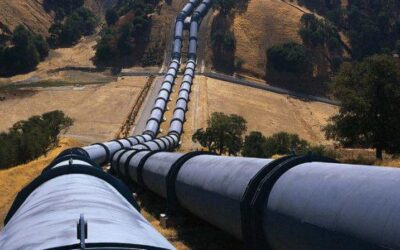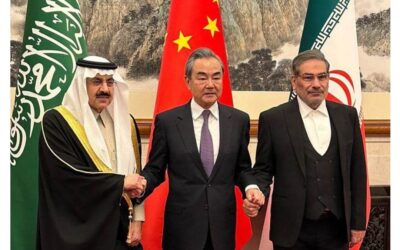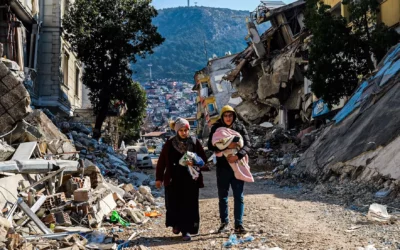The extraordinary fate of the Mediterranean
The Hundred or so generations that separate us from the first Roman endeavours to assimilate the Mediterranean area around a central power teach us strategic humility in the face of opposition from intractable framework, for the Mediterranean is not a uniform basin.
It is separated geologically by the Sherki Banks, keeping in mind that its three points of access immediately place the challenges associated with flows and security within a logic of strategic obstacles and dependence on the rivalry of contiguous regional powers.
Thus, Antiquity and the Middle Ages have witnessed periods of domination of the Mediterranean by coastal empires, without this leading to a real and lasting unification of the geostrategic space.
As a transport road that allowed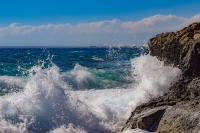 the development of the great Greco-Roman civilizations and the Judeo-Christian and Muslim religions, it was a place of trade and cultural exchange, but also the scene of the nascent naval warfare. It was its mastery that enabled the great empires to establish their dominance over the peoples who lived along its seashores.
the development of the great Greco-Roman civilizations and the Judeo-Christian and Muslim religions, it was a place of trade and cultural exchange, but also the scene of the nascent naval warfare. It was its mastery that enabled the great empires to establish their dominance over the peoples who lived along its seashores.
If the Romans succeeded in making it a Mare Nostrum over five centuries, Byzantines then Ottomans succeeded them without diminishing its distinctiveness or singularity. The great maritime cities, Venice and then its rival Genoa, promoted merchandising there, before the discovery of America then gradually shifted the trade centre of gravity westwards. Venice, finally defeated and ruined, acknowledged Turkey’s taking possession of Cyprus in exchange for the resumption of its trade, but it is the Western powers that ruled and controlled from the 17th century onwards and definitively deprived the Mediterranean of its future.
The British demonstrated their naval dominance brilliantly in a smart and cost-effective way. Using the islands and an unparalleled navy, they guaranteed a smooth flow between the United Kingdom and the Indian Empire. Over nearly a century and a half, they deployed a campaign of conquest of support points, in Gibraltar, the Balearic Islands, Malta, temporarily in Corsica, Corfu, Vis and Princes’ Island in the Bosphorus, blocking the movements of the French, the Austro-Hungarians and, finally after having secured the control of Egypt, the Ottoman Empire, who assigned Cyprus in 1878.
The French Empire mainly spread over Africa, focusing its priorities on the western part of the Mediterranean. To guarantee its extension towards the East (Suez, Lebanon, Indochina), France contributed to steady the Mediterranean with the British Empire and chose to develop three main military bases (Toulon, Bizerte, Mers El Kebir) then, in a second phase, Solenzara given the rise of Italy, Franco’s victory in Spain, and the foray of German ships in the Mediterranean. Italy, for its part, considered Corsica, Malta and Cyprus as obstacles to its own expansion. In his speech in Tripoli in April 1926, Mussolini reemployed the expression of Mare Nostrum, bearing in mind the idea of establishing an Italian Thalassocracy.
In the middle of the 20th century, a narrowing of the Mediterranean occurred virtually, due to the bipolar balance of power resulting from the Second World War. The Suez crisis demonstrated the limits of conflict management that ignored the involvement of the two major powers and convinced France to join the circle of nuclear powers. It then became the southern flank of Cold War in Europe. The stakes involved in nuclear deterrence reduced its decisive character in the game of rivalries, with plans for operations that could also be built around strikes from land, submarines operating in the Atlantic, and long-distance air raids.
In the meantime, the Mediterranean showed evidence for its economic progress and development, centred on the twenty-two countries and 150 million inhabitants. Its annual economic output is estimated to be at least €400 billion. Undoubtedly, it is now important to consider the distinctions between the three geopolitical and economic zones surrounding the market penetration level laid out in China’s New Silk Roads policy: the European Union and the candidate countries, the Middle East and North Africa. While the European Union appears to be the most advanced political and economic pool, the other regional blocs are too unstable and differentiating to imagine an endeavour at the integration of the same nature.
Ever-expanding pressure in the Mediterranean
Major competitors are playing their part in the Mediterranean, considering it above all as a main road within the value stream mapping.
As it rotated towards Asia, the United States reduced its military footprint, but will never accept the compromise of the air-sea-air corridor linking the Mediterranean and the Indian Ocean, the fastest road to the Pacific from the West. Moreover, their strategy towards Russia, which does not introduce a risk of the same nature as China – at the NSA, Rob Royce describes Russia as a hurricane and China as climate change – is dependent on containment and preventive action in conjunction with NATO. The issue emphasizes more about their ability to regain strength through accessible support points and preserving their freedom of action.
Even released from its dependence on the hydrocarbons of the Gulf countries, the United States cannot disregard the Suez Canal and the Bab el Mandeb Strait, which are central to Saudi Arabia’s economic security… and the correlated arms expenditure. Finally, the American guarantees given to Israel will limit any definitive withdrawal from Middle East affairs for a long time to come.
China has not yet finalised the entire infrastructure and communications network that will support its trade flows across the Mediterranean. One of the first episodes led to the acquisition of majority shares in the China Ocean Shipping Company (COSCO) during the privatisation process of the port of Piraeus. There is no doubt that the next step will be the military securing of its assets, with an increase in volume of combat vessels in a virtually closed sea, by coordinating its efforts from Djibouti, where its first base abroad has been established.
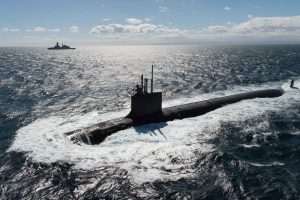
Like all shared spaces, the Mediterranean is also coveted by conquering sovereignties. Russia, together with Turkey, is located at the centre of the strategic reconfiguration that is arising in the eastern Mediterranean.
Taking advantage of the vacuum left by the United States and the guilty absence of a European power on its own borders, it manages to support its Syrian ally, demonstrating the re-establishment of its military capabilities. In this way, we can say that Russia is a double winner : it has weakened the cohesion of the Alliance by making the hypothesis of Turkey’s exit from NATO a lasting one, and it has become a key player in the Levant and the Mediterranean by establishing a strategic continuum across the Bosphorus. Clearly, Russia now holds more aces to put pressure on Europe in due time. Among the potential goals: lifting the sanctions resulting from the Ukrainian dispute, dialogue on arms control, negotiations on its gas and oil outlets, the Astana process.
However, we must be careful not to reduce security matters in the Mediterranean to the interaction of major competitors. It forms a historical and bloody crossroad of the three monotheist religions, an area of human and commercial traffic, the planet’s leading energy route on a seabed covered with the arterial cables of globalisation. Gas resources were discovered in a historically disputed territorial perimeter. It is also a world tourist destination, and a symbolic burden in the melting pot of Western civilisations. All sorts of interests and human destinies collide there. Do you have any evident proof of humanity in the past that peaceful coexistence was ever possible under such circumstances and without integrating tragic disasters? At the very least, the militarization of the Mediterranean seems to be inevitable.
In concrete terms, the risks of incidents are increasing, or rather their staging, as the distorting information and hybridity warfare seems to become a standard under multiple aspects.
The multiplication of actors, and the inevitable duplicity that this involves, blur the stated or real intentions. Combat ships and aircraft crew, rotating between core military missions, sea policing, sovereignty actions, or safeguarding shipwrecked migrants, measure the complexity of switching from one framework of legitimacy to another on a day-to-day basis. The presence of increasingly sophisticated defence systems on ships or ashore increases the risk of misunderstandings during manoeuvres and raises the need for intelligence and situation assessment. Authoritarian powers in the basin are tempted to use risk strategies and intimidation, which might find more scope for influence in the maintenance of instability. The latest developments in the chaos in Libya bear witness to this, with the continued deployment of armaments and the importation of jihadist fighters from the Syrian pocket of Idlib sponsored by Turkey, which thus appropriates a second lever of influence over the European Union in the management of migrant reservoirs, but also in its demands to exploit the Mediterranean gas fields. The recent naval incident between the frigate Le Courbet engaged in the NATO Sea Guardian operation and the Turkish ship Oruçreis, deliberately trying to prevent it from controlling a merchant ship suspected of arms trafficking to Libya, illustrates the type of escalation that will have to be controlled in the future, moreover between member countries of the same alliance.
Multiple interacting strategies
Given the complexity of international relations and the geostrategic stakes of the area, the political dialogue around the Mediterranean Sea is structured around cooperation and the major security organisations: Common Security and Defence Policy of the European Union, 5+5 Dialogue, Mediterranean Dialogue, Barcelona Process.
Tools have been put in place, such as the European operation Sophia, which was succeeded by Operation Irini, Operation Sea Guardian, and the creation of the European agency Frontex, which reflect the shared interest in maintaining freedom of movement, economic development and cooperation in crisis management, whether in terms of security, environmental challenges or migration.
But the results are still not commensurate with the challenges. The cultural rationale of the North differs greatly from that of the South. The normative vector and economic power, Europe’s preferred tools, are not enough and an increasing number of countries are opting for the pragmatism of bilateral agendas. Beyond that, short-term sovereign interests are setting precedence over values, and competition or the addition of cooperation offers is preferred to long-term strategic partnerships.
Our Armed Forces, structured by a cadre that can support exports, enhance operational cooperation around key capabilities, develop skills through exercises, or lead coalitions, allow us to take initiatives while making sure that we do not practice exclusive interoperability. The so-called able and willing approach, which also prevails in the “European Intervention Initiative”, allows for differentiating and concrete approaches.
Our priorities on the southern flank are to protect the approaches to the national territory, to maintain an autonomous assessment of the situation, to cooperate with the southern seashore countries, and to ensure a forward defence aimed at compartmentalising hotbeds of terrorism.
As such, the security cord formed by the five North African countries is extremely fragile. In the West, Morocco is seeing a reorientation of migratory flows towards its territory. Despite the remarkable strategic patience of its population, Algeria’s destiny seems to have been put on hold. Tunisia is consolidating its transition on condition that it can protect its borders from terrorist overflows. Libya is sinking into chaos and sees its future increasingly being written in Istanbul, Cairo and even Moscow and Abu Dhabi, but in no case in Brussels, while European security interests are the first to be affected. In Egypt, the powerful ideological currents of the Muslim Brotherhood continue to fester.
Beyond that, the recent destabilisation of Iraq, resulting from the peak of Iranian-American peak of escalation, raises fears of violent aftershocks on the coastal countries, particularly in Israel and Lebanon.
In spite of factors that tend to find the convergence criteria for a collective future, such as culture, the ecology of the sea or insular identity, the Mediterranean brings together too many contrasts and complexities to be thought of as a coherent whole. Its eastern side concentrates energy, security and inter-religious challenges. Its southern area remains a mosaic of uncertainties. Its western part, relatively unaffected so far, could become the main corridor for African migration towards Europe.
Multiple disruptive factors will persist in the medium term across what might constitute the strategic “doldrums” in Europe’s immediate southern belt. The first half of the 21st century has confirmed that security balances in the Mediterranean region are the result of confrontations between adjacent geostrategic areas, but also of rivalries between major competitors who may alternately show that they are powerful or harmful and, more rarely, display evidence of their goodwill. Thanks to its complex and tragic history, Europe is in the better position to understand this highly uncertain Mediterranean area, to take a more active part in its strong interactions and, above all, to understand the essential constituent and animating spirit of its history.
Source: Fondation Robert Schuman – The research and Studies Centre on Europe
Author: Amiral Jean Casabianca – Major General of the Armed Forces

